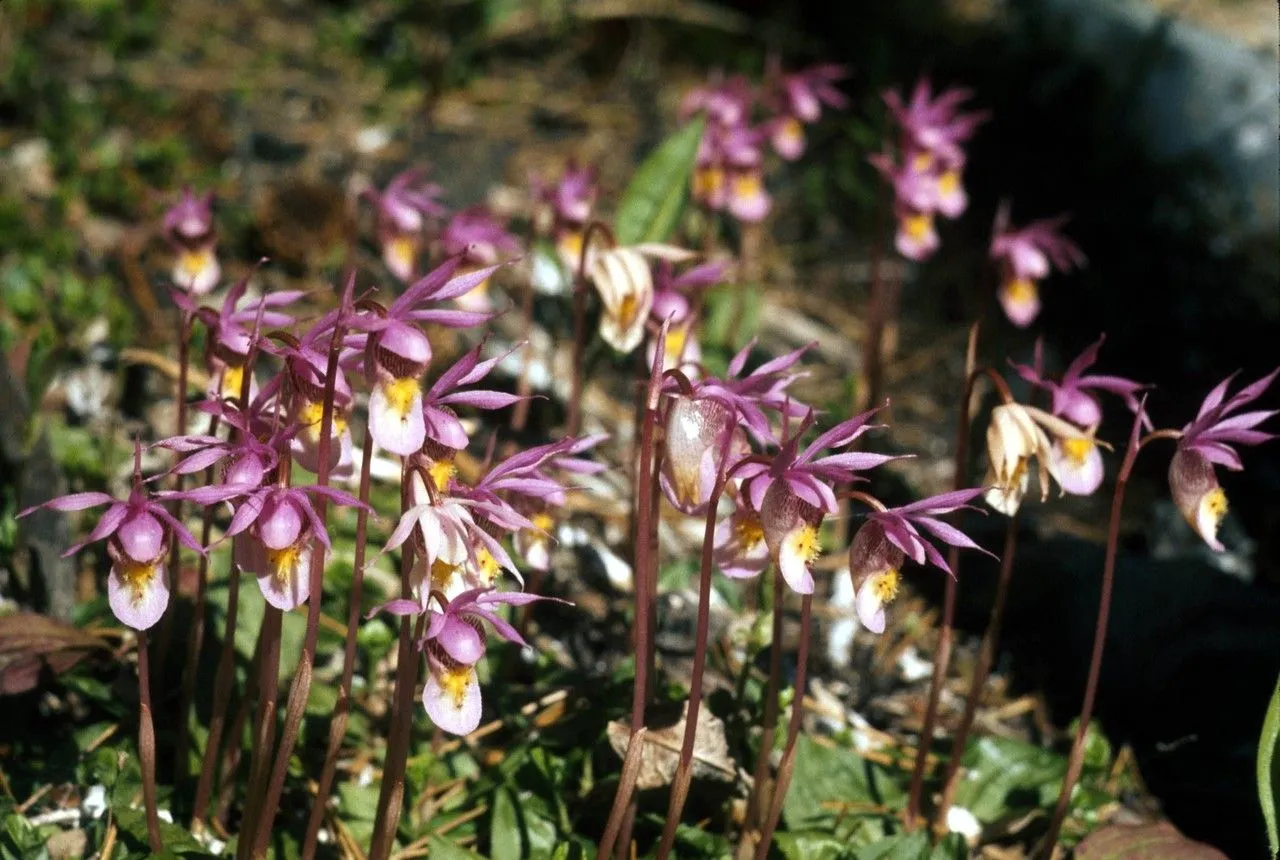
Author: (L.) Oakes
Bibliography: Cat. Vermont Pl.: 28 (1842)
Year: 1842
Status: accepted
Rank: species
Genus: Calypso
Vegetable: False
Observations: Subarctic & Temp. Northern Hemisphere
Calypso, scientifically known as Calypso bulbosa, is a unique and fascinating orchid that captivates both botanists and nature enthusiasts alike. This delicate plant belongs to the Orchidaceae family, a group renowned for their diverse and often intricate floral structures. Calypso bulbosa is noteworthy not only for its beauty but also for its specific habitat preferences and conservation status.
Commonly referred to simply as Calypso, this orchid thrives in the subarctic and temperate regions of the Northern Hemisphere. Its distribution includes a variety of forested areas, often in rich, shaded woodland environments where it benefits from the cool, moist conditions. Calypso stands out due to its striking appearance – a single, enchanting pink to purple flower that emerges from a solitary basal leaf. The flower’s structure is complex, with a slipper-shaped lip that’s usually adorned with darker markings and intricate patterns, providing visual appeal and aiding in its pollination strategy.
Since its formal description in the Catalogue of Vermont Plants in 1842, Calypso has intrigued botanists, including the author (L.) Oakes, who first documented its characteristics and habitat. The plant’s name, inspired by the nymph Calypso of Greek mythology, suggests a hidden beauty worthy of discovery and admiration – much like the elusive orchid itself.
One of the unique aspects of Calypso is its pollination mechanism. Unlike many other orchids, it does not produce nectar. Instead, it relies on visual attraction to lure in pollinators, typically small bees. These insects, deceived by the flower’s vivid colors and enticing patterns, inadvertently aid in the plant’s reproduction by transferring pollen as they move from flower to flower.
The lifecycle of Calypso is equally fascinating. It is a perennial plant, albeit one with specific and somewhat sensitive growth requirements. Its dependency on particular fungi for nutrient uptake, a common trait among many orchids, makes it particularly susceptible to changes in its environment. Consequently, populations of Calypso bulbosa are indicators of the health of their native habitats. Due to these narrowly defined ecological niches and their vulnerability to habitat disruption, Calypso is often considered a species of concern in various regions.
In summary, Calypso (Calypso bulbosa) is an enchanting orchid exhibiting both beauty and ecological intrigue. Its presence across the subarctic and temperate regions of the Northern Hemisphere highlights the plant’s adaptation to specific habitats and climatic conditions. First cataloged in the mid-19th century by (L.) Oakes, it continues to be a subject of fascination due to its distinctive floral characteristics and its dependency on symbiotic relationships within its environment. Protecting the delicate ecosystems that support Calypso is essential to ensuring that this botanical gem continues to enchant future generations.
Eng: calypso, fairy slipper, fairy-slipper, fairy-slipper orchid, fairyslipper, fairyslipper orchid, venus’s slipper, venus’ slipper
Swe: norna
Fra: calypso bulbeux, calypso bulbeuse
Nob: norne
Nno: norne
En: Calypso, Fairy-slipper, Venus’s slipper, Fairy slipper, Fairy-Slipper Orchid, Fairy slipper orchid, FAIRYSLIPPER, Fairyslipper orchid, Calypso orchid, Venus’ slipper
Ba: Калипсо
Zh: 布袋兰, 布袋兰属
Cs: Kalypso severní
Nl: Bosnimf
Et: Haldjaking
Fi: Neidonkenkä
Fr: Calypso bulbeux, Calypso bulbeuse
De: Norne
It: Calipso
Kv: Калипсо
No: Norne
Nb: Norne
Nn: Norne
Ru: Калипсо луковичная
Es: Zapatilla de Venus
Sv: Norna
Zh-hant: 布袋蘭屬
Taken Jan 1, 1900 by EOL − Jason Hollinger (cc-by)
Taken Aug 9, 2022 by #MaryKingfishers MK (cc-by-sa)
Taken Apr 21, 2021 by Deep Waters (cc-by-sa)
Taken Apr 4, 2021 by Justin Wheeler (cc-by-sa)
Taken Apr 6, 2019 by John Wolfstone (cc-by-sa)
Taken Jan 1, 1900 by EOL − Cooper, G.A. (cc-by-nc-sa)
Taken Jan 1, 1900 by EOL − Cooper, G.A. (cc-by-nc-sa)
Taken Jan 1, 1900 by EOL − Cooper, G.A. (cc-by-nc-sa)
Taken Apr 13, 2016 by EOL − eloweecey (cc-by-nc)
Taken Jan 1, 1900 by EOL − Cooper, G.A. (cc-by-nc-sa)
Taken Apr 22, 2015 by EOL − Zoya Akulova (cc-by-nc)
Taken Jan 1, 1900 by EOL − Walter Siegmund (cc-by-sa)
Taken Apr 22, 2015 by EOL − Zoya Akulova (cc-by-nc)
Taken Jan 1, 1900 by EOL − Walter Siegmund (cc-by-sa)
Taken Dec 7, 2008 by EOL − Keir Morse (cc-by-nc-sa)
© copyright of the Board of Trustees of the Royal Botanic Gardens, Kew.
© copyright of the Board of Trustees of the Royal Botanic Gardens, Kew.
© copyright of the Board of Trustees of the Royal Botanic Gardens, Kew.
Growth habit: Forb/herb
Family: Myrtaceae Author: (F.Muell.) K.D.Hill & L.A.S.Johnson Bibliography: Telopea 6: 402 (1995) Year: 1995 Status:…
Family: Rubiaceae Author: Pierre ex A.Froehner Bibliography: Notizbl. Bot. Gart. Berlin-Dahlem 1: 237 (1897) Year:…
Family: Sapindaceae Author: Koidz. Bibliography: J. Coll. Sci. Imp. Univ. Tokyo 32(1): 38 (1911) Year:…
Family: Asteraceae Author: A.Gray Bibliography: Pacif. Railr. Rep.: 107 (1857) Year: 1857 Status: accepted Rank:…
Family: Fabaceae Author: Medik. Bibliography: Vorles. Churpfälz. Phys.-Ökon. Ges. 2: 398 (1787) Year: 1787 Status:…
Family: Aspleniaceae Author: (Cav.) Alston Bibliography: Bull. Misc. Inform. Kew 1932: 309 (1932) Year: 1932…